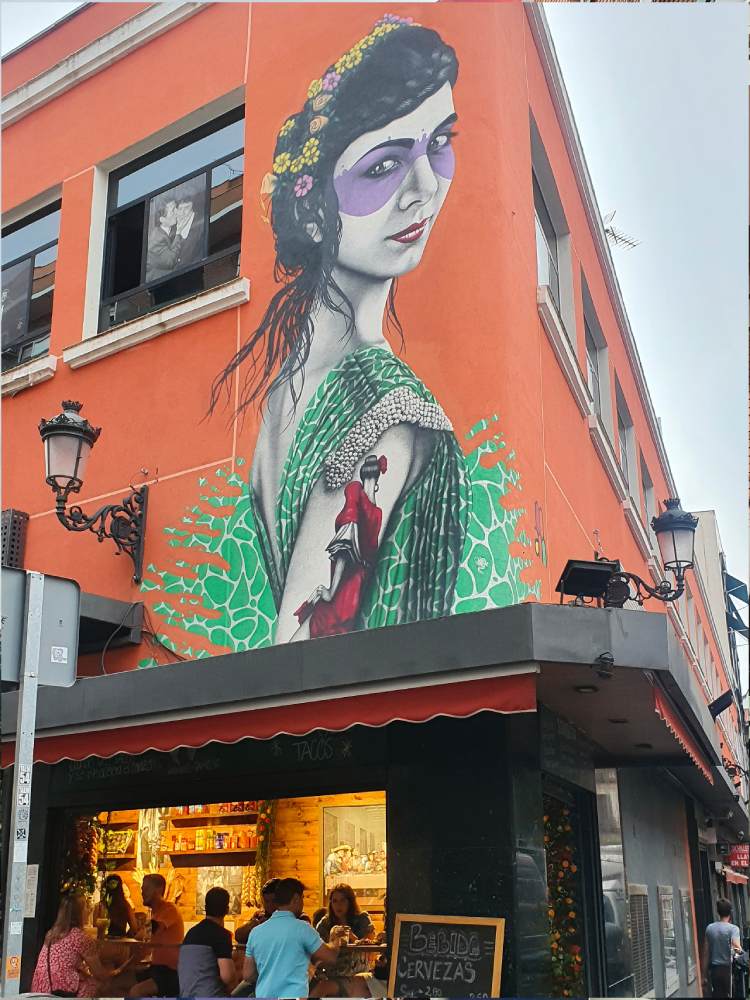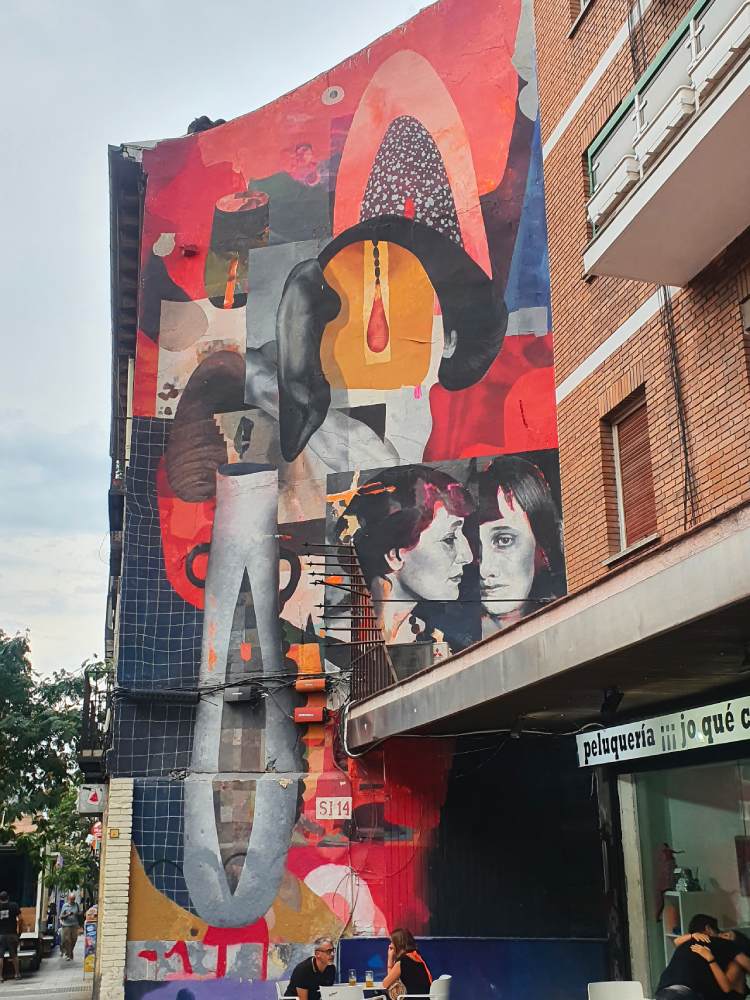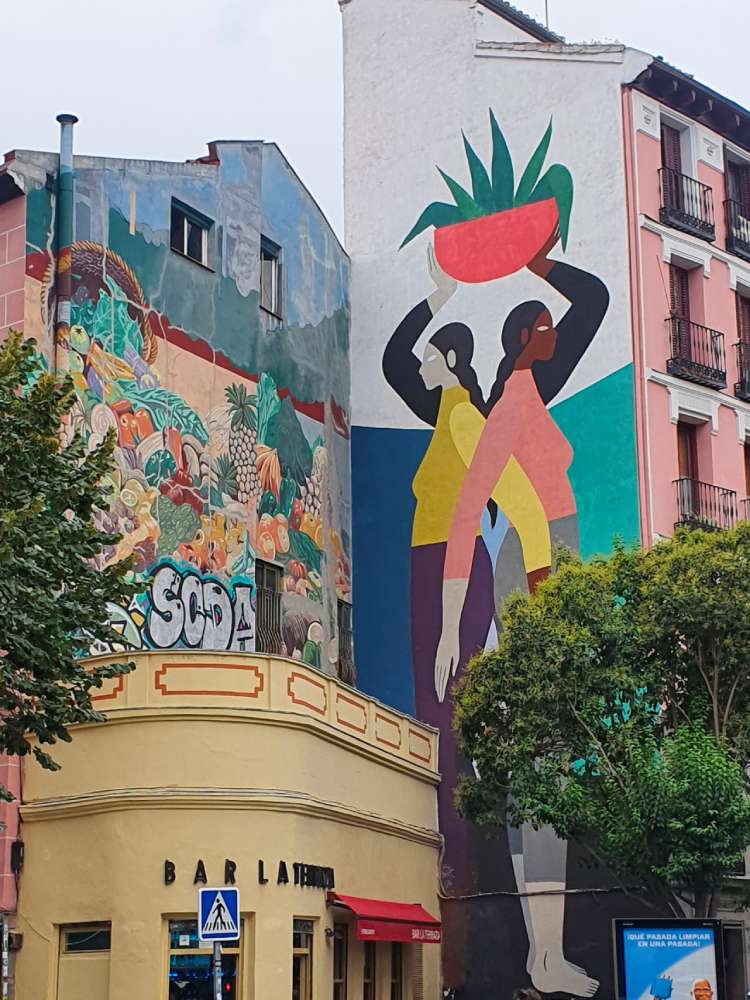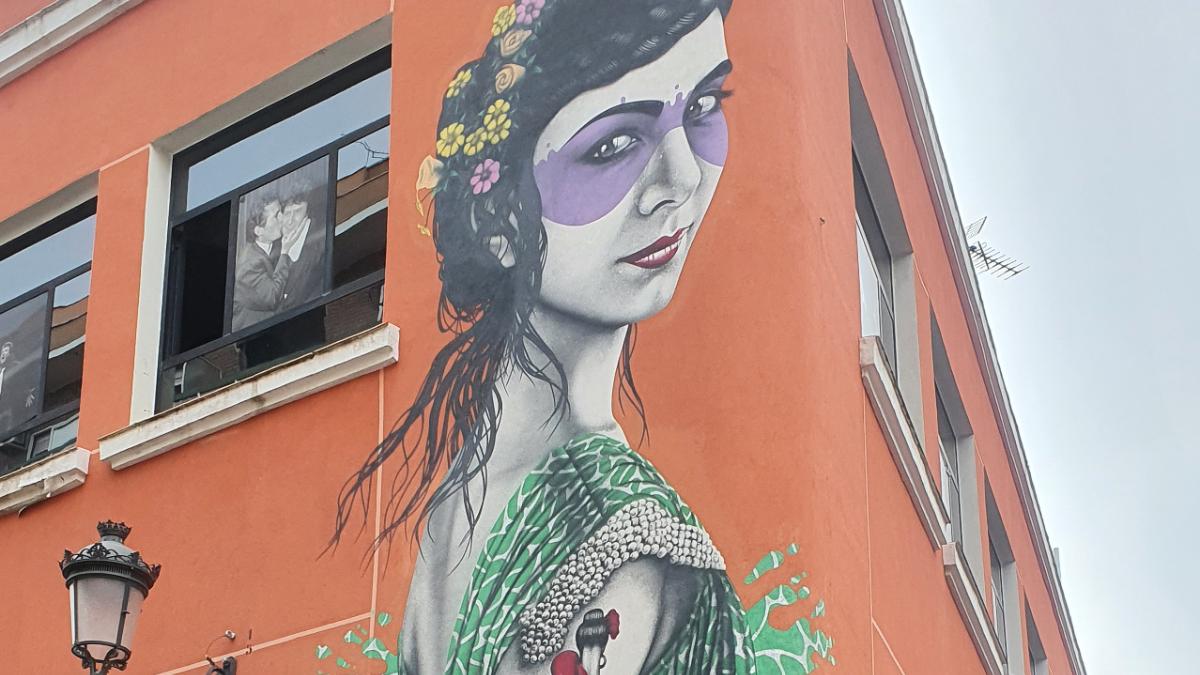Click here to read the Spanish version.
In recent years some of the best street art artists in the world have traveled to Madrid with their espráis. We propose a bullfighting vermouth to enjoy their creations on facades and midtowns, leaning on some of the most disputed bars of Antón Martín, Sol and Embajadores. A tour not to look at the clock and look up.
We meet at La Consentida de Doré to start our tour with one of the 45 varieties of gildas that José sells in one of the street stalls of the Antón Martín market. Hidden away at number 3 of the Doré passage, here they serve El Bandarra vermouths with the marinated herring gilda or the popular ‘matrimonio’.

Desde la fachada del Mercado de Antón Martín nos observa “Isabelita” obra del irlandés Fin DAC.
After this authentic street food experience, we only have to take a few steps to fulfill the mission that has brought us here. From the main façade of the Antón Martín Market, Isabelita questions us with an enigmatic look. The masked woman is one of the typical works of the Irish artist Fin DAC (pseudonym of Finbarr Notte), comic-inspired women that the most alternative of Madrid’s gastromarkets has adopted as its identity after being repainted in 2015.
Just across the street is another interesting work on Santa Isabel Street. On a midday wall at number 18, the Russian Marat Morik offers a dreamlike scenography in homage to the poetess and compatriot, Anna Akhmatova. Like other murals on the tour, this one was made possible thanks to the initiative of the promoters of Urvanity Art, the Madrid fair of new contemporary art.
The collage bill of The Rhyme of Things offers different views of the artist, which are more comfortable to observe from one of the tables of Más Corazón. For 11 years, this dark place has been gathering a varied fauna in the purest eighties style to enjoy their beers, while sharing the cachopo of cecina or ham on Saturdays or their cocidos (stews).

Homenaje del ruso Marat Morik a la poetisa Anna Ajmátova en el 18 de la calle Santa Isabel.
Mystery shrimp
There is no bullfighter’s vermouth without a serving of prawns, and in Perlora seafood restaurant they serve some of the best grilled Ayamonte in the city. You only have to walk a few meters to get to number 40 Magdalena street.
In the brief and cozy bar that precedes the dining room, Mino (from Belarmino) has just placed on the display his famous tortilla paisana with cod, a very elaborate recipe (without potato) as succulent as it is juicy in the mouth. The iodized oysters and its special wine list served in glasses, are other temptations to which the attentive Mino invites.
Satisfied, we did not look out to enjoy Byte the Candy, by Jorge Rodriguez-Gerada. The Cuban-American artist, who participated in New York’s cultural renaissance in the 1990s, illuminates this popular street with the false serenity of his portrait: the tranquility he offers in the distance turns into confusion when we discover that his two pupils are actually on buttons.
Taking the Cañizares perpendicular, you can walk down the street until you reach our next stop, a gastronomic sanctuary with more than 180 years of history. Recently rescued from its uncertain future by the also centenary Grupo Pescaderías Coruñesas of the García Azpiroz family, Lhardy defends its essence with a management more in tune with the times.
On the first floor of the aristocratic restaurant located on the second floor of 8 San Jeronimo Street, its fantastic Cuban mahogany wood façade was erected around 1880. An exquisite access to the secluded store where it is now possible to continue enjoying its famous consommé accompanied by truffled sausage puff pastry or the kidney barqueta.
After the snack we approached the passage of the Caja de Ahorros (Puerta del Sol corner with Alcalá street). There, hidden from the hustle and bustle, the first work in the capital of the German Case Maclaim (Andreas Van Chrzarowski). Considered one of the masters of the photorealistic mural in the world, he shows his mastery with a powerful image of disability empowerment in which a boy (or girl) appears seated in a wheelchair showing off his mermaid tail.

“El Pilar”, de Poni (Hilda Palafox), un homenaje a la sororidad, en la Plaza de Puerta Cerrada.
Crossing the Plaza Mayor, one arrives at the Plaza de Puerta Cerrada for the penultimate stop on this tour. On one of the two walls of what was once the masterpiece of Madrid street art, El Gallo Carnicero, by Alberto Corazón (chosen by Newsweek for the cover of an issue on Madrid’s new wave), the Mexican Poni (Hilda Palafox) painted El Pilar in 2019: a tribute to sisterhood among women of any race and condition.
Its view can be enjoyed comfortably from three Latoneros Street: we are in Casa Revuelta, a traditional Madrid tavern now renovated without losing its patina. Hundreds of portions of torreznos (bacon rashers) and slices of cod in batter are sold here daily. “Crunchy on the outside and juicy on the inside”, its waiters proclaim while customers queue up.
In 1925 Alfonso XIII and Victoria Eugenia de Battenberg attended the premiere of Don Quintín el amargao at the newly built Pavón Theater. Its opening had aroused great expectation as it was one of the most beautiful examples of art deco in the capital, a splendor it lost in the 1950s when it was converted into a cinema. Fortunately, with the turn of the century, a new theatrical project recovered the essence of the building, including the café on the first floor.
Here we make the last gastro stop of this mural art tour for a michelada, the Mexican cocktail made with beer, lime juice, salt and, of course, spicy. A good accompaniment to the pastrami sandwich while observing the colorful fauna that frequents this place with its infinite ceiling.
For dessert we walk down Embajadores street to number 19. Opposite each other we have two spectacular murals, Runaway, by the British artist DFace, shows a passionate couple dripping paint in their embrace, in a clear style of classic American comics. In front of it we find a creation by the Argentinean Ever (Nicolás Romero) entitled Still Life Lavapiés. The mural seems to pay homage to the nearby Rastro in a symbiosis of objects and cats framed by two dancing giants by Matisse.

